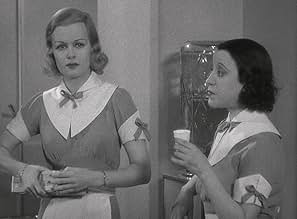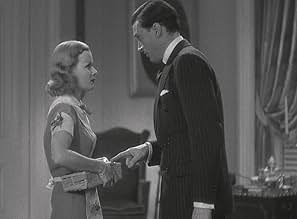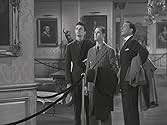NOTE IMDb
6,5/10
1,2 k
MA NOTE
Ajouter une intrigue dans votre langueSassy manicurist Eve Fallon is recruited as an even more brassy reporter and she helps police detective boyfriend Danny Barr break a jewel theft ring and solve the murder of a baby.Sassy manicurist Eve Fallon is recruited as an even more brassy reporter and she helps police detective boyfriend Danny Barr break a jewel theft ring and solve the murder of a baby.Sassy manicurist Eve Fallon is recruited as an even more brassy reporter and she helps police detective boyfriend Danny Barr break a jewel theft ring and solve the murder of a baby.
- Réalisation
- Scénario
- Casting principal
- Récompenses
- 2 victoires au total
Henry Brandon
- Don Butler
- (as Henry Kleinbach)
Fred Anderson
- Elevator Operator
- (non crédité)
William Arnold
- Customer
- (non crédité)
Mary Bovard
- Manicurist
- (non crédité)
Don Brodie
- Customer
- (non crédité)
Ralph Brooks
- Man Exiting Elevator
- (non crédité)
Avis à la une
"Big Brown Eyes" is from 1936 and directed by Raoul Walsh. Joan Bennett was still a blond, and here, Cary Grant plays Dan Barr, a detective trying to recover someone's stolen jewels. Bennett plays his jealous manicurist girlfriend Eve, who takes a job on a newspaper after she quits manicuring.
Walter Pidgeon plays Cortig, the head of the jewel theft ring which is also involved in the murder of a child who was hit by one of Cortig's stray bullets. He's joined by Lloyd Nolan. Thanks to his crooked attorney, Cortig is found not guilty. Dan is so upset he quits the force to go out on his own and get justice. Eve returns to her manicure job; both are very defeated by the trial.
This is an okay, fast-moving film with Bennett playing what today would be considered a stereotype, you know, the gum-cracking, wisecracking blond. Grant is very handsome and slips easily into his role. He's not the "Cary Grant" persona quite yet. That's a couple of years away.
I don't know who the Big Brown Eyes were, but it must have been Cary Grant. I saw Joan Bennett in person near the end of her life - she was very tiny, with very black hair, and had beautiful blue eyes.
Walter Pidgeon plays Cortig, the head of the jewel theft ring which is also involved in the murder of a child who was hit by one of Cortig's stray bullets. He's joined by Lloyd Nolan. Thanks to his crooked attorney, Cortig is found not guilty. Dan is so upset he quits the force to go out on his own and get justice. Eve returns to her manicure job; both are very defeated by the trial.
This is an okay, fast-moving film with Bennett playing what today would be considered a stereotype, you know, the gum-cracking, wisecracking blond. Grant is very handsome and slips easily into his role. He's not the "Cary Grant" persona quite yet. That's a couple of years away.
I don't know who the Big Brown Eyes were, but it must have been Cary Grant. I saw Joan Bennett in person near the end of her life - she was very tiny, with very black hair, and had beautiful blue eyes.
This little movie is more than forgotten. It is so mundane that no one has decided they can make a nickle from it, despite having some of the very same features and creative crew as projects that are celebrated. Cary Grant is about the same here, as in, say, "Charade."
I have to admit, it is flat. It all can be laid at the feet of the writer, I suppose.
These comedies are delicate. I suppose they cannot be engineered, like so much in film can. Oh, the execution can of course, but if the writer doesn't froth intuitively, nothing can spin it in after the fact.
But then again, this was the 30's where experimentation was the rule. And I suppose you need several failures before you get a "His Girl Friday" (which this resembles) out of so many tries.
Ted's Evaluation -- 1 of 3: You can find something better to do with this part of your life.
I have to admit, it is flat. It all can be laid at the feet of the writer, I suppose.
These comedies are delicate. I suppose they cannot be engineered, like so much in film can. Oh, the execution can of course, but if the writer doesn't froth intuitively, nothing can spin it in after the fact.
But then again, this was the 30's where experimentation was the rule. And I suppose you need several failures before you get a "His Girl Friday" (which this resembles) out of so many tries.
Ted's Evaluation -- 1 of 3: You can find something better to do with this part of your life.
And in that of Raoul Walsh, as well. The early scenes, which try really hard to be cute, show no influence of Walsh. When it gets more into the career of policeman Grant, we see some fast-paced action and it makes sense as a Walsh project. Sort of.
Grant was young and hadn't become a major star yet. He looks great and does a creditable job. His female co-star is Joan Bennett. Now there was an interesting actress: She worked with all the great foreign directors when they came to Hollywood. She made several movies for Fritz Lang. She worked for Max Ophuls. She worked for Jean Renoir.
Here she is a blonde, like sister Constance. She's fine.
Walter Pidgeon looks young too. He is cast in the sort of role Robert Montgomery or Warren William got more frequently: He's a charming crook.
When the movie begins, Bennett is a manicurist. Then, suspiciously quickly, she's an ace newspaper reporter. Was this little film assembled from various attempts or is the plot just a little unconvincing? There are many wonderful reaction shots that move quickly from close-up of one bit player or extra to close-up of another. I think the most famous use of this sort of extreme close-up is that of the chatty woman in "Brief Encounter." But the ones here are great. Indeed, they elevate what is essentially a trivial movie up a notch or two.
Grant was young and hadn't become a major star yet. He looks great and does a creditable job. His female co-star is Joan Bennett. Now there was an interesting actress: She worked with all the great foreign directors when they came to Hollywood. She made several movies for Fritz Lang. She worked for Max Ophuls. She worked for Jean Renoir.
Here she is a blonde, like sister Constance. She's fine.
Walter Pidgeon looks young too. He is cast in the sort of role Robert Montgomery or Warren William got more frequently: He's a charming crook.
When the movie begins, Bennett is a manicurist. Then, suspiciously quickly, she's an ace newspaper reporter. Was this little film assembled from various attempts or is the plot just a little unconvincing? There are many wonderful reaction shots that move quickly from close-up of one bit player or extra to close-up of another. I think the most famous use of this sort of extreme close-up is that of the chatty woman in "Brief Encounter." But the ones here are great. Indeed, they elevate what is essentially a trivial movie up a notch or two.
Big Brown Eyes would have been a big fat bomb if Cary Grant hadn't carried the movie. Even in such an early picture (1936) his debonair, yet cheeky gentleman style is evident. Playing a detective seemed odd, yet no matter what role he is cast in, he makes it his own. His romantic interest, Joan Bennett, seemed a tad too hard around the edges to play his girlfriend, but she did manage some decent repertoire with Grant, especially when the packing scene in Grant's apartment. Overall, the picture is uneven. It can't decide if it is a serious crime/drama or a light comedy. There is a scene where a stray bullet kills a baby (intimated) and there is nothing funny about that. Another scene a man is shot while arranging roses. It's incongruent action like these scenes that makes this movie just short of unwatchable. I have yet to see a Cary Grant movie that I didn't like, and this one seems a practice for his all out great flick His Gal Friday. Big Brown Eyes is watchable, only because of Cary Grant.
Big Brown Eyes (1936)
Well, the big brown eyes that come to mind here belong to Cary Grant, who is coming into his own here. You'll recognize not only the looks (the eyes are heavier in the earlier films) but a mature attitude, the relaxed and cocky and sarcastic fellow that is so famous.
The leading woman is Joan Bennett, who plays Grant's love interest. Bennett is not well known as a type the way Crawford or other women from her period are, and it's partly because she plays a kind of generic character, in this case a blond, sweet, smart, fun woman. She actually became more famous later in a couple Fritz Lang dramas (as a brunette), also playing a type. what she had going for her was a natural and fluid ease before the camera. And an ability to fit a part, not steal the show.
Because the show belongs to Grant. And Grant here is a cop, Danny Barr. He tends to insert his casual confidence and slow ease as a cop and it's actually a pretty interesting fit, not at all the stereotype created by harder boiled types, or more witty ones (name a half a dozen famous ones). It's fascinating to watch him at this pivotal point in his career. It's usually pointed out that Grant's persona solidified in 1937 in "The Awful Truth" but having watched most of these films from this period it really seems that he's fully himself here, a year earlier. History is right in the sense that "The Awful Truth" pushed Grant's career up a notch simply because it's a better movie. And he has a more prominent role in it.
Here, the action is spread between Grant and his cops, Bennett and her life bouncing from being a manicurist to a reporter, and the "bad guys" who are up to their usual no good. These thugs are actually pretty convincing, falling short of the hardened awful types of some movies. One of them (the kingpin) is a young Walter Pidgeon, who is not quite right in his role, but it's fun to see him so early in his career.
"Big Brown Eyes" is poorly name, but besides that it's not a bad movie at all, and if you follow the several plot lines (all connected) it gets pretty interesting. Every now and then when the plot is sped up (thankfully) the camera shows a whole range of characters close up and at a tilt. It's both affected (a little at odds with the rest of the movie) and successful (at speeding up the plot with appropriate humor and agitation). There are some fun twists (like when Bennett accidentally makes a fingerprint dusting using some talcum powder. And there are lots of turns, people quitting jobs and leaving town, and some odd shocks, as when the baby is killed.
In the end it's also a romance with Grant in the lead role, well done and sharply acted. See it.
Well, the big brown eyes that come to mind here belong to Cary Grant, who is coming into his own here. You'll recognize not only the looks (the eyes are heavier in the earlier films) but a mature attitude, the relaxed and cocky and sarcastic fellow that is so famous.
The leading woman is Joan Bennett, who plays Grant's love interest. Bennett is not well known as a type the way Crawford or other women from her period are, and it's partly because she plays a kind of generic character, in this case a blond, sweet, smart, fun woman. She actually became more famous later in a couple Fritz Lang dramas (as a brunette), also playing a type. what she had going for her was a natural and fluid ease before the camera. And an ability to fit a part, not steal the show.
Because the show belongs to Grant. And Grant here is a cop, Danny Barr. He tends to insert his casual confidence and slow ease as a cop and it's actually a pretty interesting fit, not at all the stereotype created by harder boiled types, or more witty ones (name a half a dozen famous ones). It's fascinating to watch him at this pivotal point in his career. It's usually pointed out that Grant's persona solidified in 1937 in "The Awful Truth" but having watched most of these films from this period it really seems that he's fully himself here, a year earlier. History is right in the sense that "The Awful Truth" pushed Grant's career up a notch simply because it's a better movie. And he has a more prominent role in it.
Here, the action is spread between Grant and his cops, Bennett and her life bouncing from being a manicurist to a reporter, and the "bad guys" who are up to their usual no good. These thugs are actually pretty convincing, falling short of the hardened awful types of some movies. One of them (the kingpin) is a young Walter Pidgeon, who is not quite right in his role, but it's fun to see him so early in his career.
"Big Brown Eyes" is poorly name, but besides that it's not a bad movie at all, and if you follow the several plot lines (all connected) it gets pretty interesting. Every now and then when the plot is sped up (thankfully) the camera shows a whole range of characters close up and at a tilt. It's both affected (a little at odds with the rest of the movie) and successful (at speeding up the plot with appropriate humor and agitation). There are some fun twists (like when Bennett accidentally makes a fingerprint dusting using some talcum powder. And there are lots of turns, people quitting jobs and leaving town, and some odd shocks, as when the baby is killed.
In the end it's also a romance with Grant in the lead role, well done and sharply acted. See it.
Le saviez-vous
- AnecdotesAt 20 minutes, Eve Fallon (Joan Bennett) says to Danny Barr (Cary Grant), with a flirtatious wink, "if you happen to be around my way, come up and see me some time". This appears to refer to a famous, almost identical line said by Mae West to Cary Grant in "She Done Him Wrong" (1933), a playful in-joke that would have been obvious to contemporary audiences.
- Citations
Richard Morey: Cortig, if you bought a gift for a girl and she refused to accept it, what would you do?
Russ Cortig: [with a slow smile] I'd give it to my wife.
- ConnexionsFeatured in The True Adventures of Raoul Walsh (2014)
Meilleurs choix
Connectez-vous pour évaluer et suivre la liste de favoris afin de recevoir des recommandations personnalisées
- How long is Big Brown Eyes?Alimenté par Alexa
Détails
- Durée1 heure 17 minutes
- Couleur
- Rapport de forme
- 1.37 : 1
Contribuer à cette page
Suggérer une modification ou ajouter du contenu manquant

Lacune principale
By what name was Empreintes digitales (1936) officially released in India in English?
Répondre
































